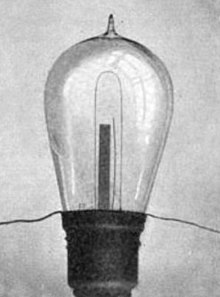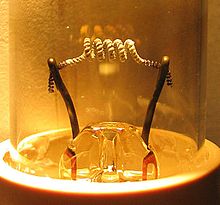Emisja termoelektronowa

Emisja termoelektronowa – emisja elektronów przez rozgrzane ciała, w wyniku cieplnego pobudzenia elektronów. Dla większości ciał emisja termoelektronowa zachodzi w temperaturach powyżej 1000 kelwinów, a dla trudnotopliwych metali w temperaturach powyżej 2000 K.
Zjawisko znalazło szerokie zastosowanie w lampach elektronowych.
Historia
Zjawisko to było wzmiankowane w 1873 roku przez Guthrie, opisuje on, że silnie rozgrzane żelazo umieszczone w próżni wysyła ładunki ujemne, ale nigdy nie udało mu się uzyskać ładunków dodatnich. Powtórnym odkrywcą był Thomas Edison (13 lutego 1880), który badał konstruowane przez siebie żarówki. On także zauważył jednokierunkowość prądu płynącego w bańce między rozgrzanym włóknem a zimną elektrodą.
Brytyjski fizyk John Ambrose Fleming zastosował opisane przez Edisona zjawisko do detekcji fal radiowych, konstruując dwuelektrodową lampę próżniową (diodę), którą opatentował 16 listopada 1904 roku.
Owen Richardson badający zjawisko emisji termoelektronowej sformułował wzór określający gęstość prądu emisji i otrzymał w 1928 roku nagrodę Nobla w dziedzinie fizyki „za prace dotyczące termoemisji elektronów, a w szczególności za odkrycie prawa nazwanego jego imieniem”.
Prawo Richardsona
Rozgrzany metal lub tlenek metalu emituje elektrony. Gęstość prądu emisji J określona jest wzorem:
Gdzie A, zwana stałą Richardsona, określona jest wzorem:
- T – temperatura w kelwinach,
- W – praca wyjścia elektronu z metalu,
- k – stała Boltzmana,
- m i e – masa i ładunek elektronu,
- h – stała Plancka.
Bibliografia
- Termoemisja elektronów z powierzchni metali, materiały dydaktyczne UJ
- T. Wiktorczyk, Zjawisko termoemisji elektronów, materiały dydaktyczne PWr [zarchiwizowano 2009-11-22, data dostępu 2015-01-31]
- Mikroskopia elektronowa > Emitery, materiały dydaktyczne UMCS
- Pomiar pracy wyjścia termoelektronów. [zarchiwizowane z tego adresu]., materiały dydaktyczne ZUT
Media użyte na tej stronie
A replica of one of the bulbs with which Thomas Alva Edison discovered the Edison Effect (thermionic emission) in the early 1880s. Made by Clayton H. Sharp in 1921 as an experiment to see if Edison's bulb could be used like a Fleming valve as a detector in a radio receiver to rectify radio waves. It worked.
It consists of an Edison incandescent light bulb, an evacuated glass bulb with a hairpin shaped bamboo carbon filament, with an additional platinum plate (visible between the arms of the filament) attached to wires emerging from the base of the bulb. A current through the filament heated it white-hot. Edison discovered that the hot filament emitted negatively-charged particles (later descovered to be electrons) an effect that was called the Edison effect. He demonstrated this by applying a separate voltage between the filament and plate. When the plate had a positive voltage, the electrons were attracted to it and a current flowed through the tube from filament to plate. When the plate had a negative voltage, the electrons were repelled so no current flowed through the tube. Edison found no practical use for this effect, but in 1904 John Ambrose Fleming invented a similar tube called the Fleming valve which was used to rectify radio signals in the first radio receivers, which evolved into the diode vacuum tube.
Autor: Created by Deglr6328, uploaded by Superclemente, Licencja: CC-BY-SA-3.0
Thermionic filament


